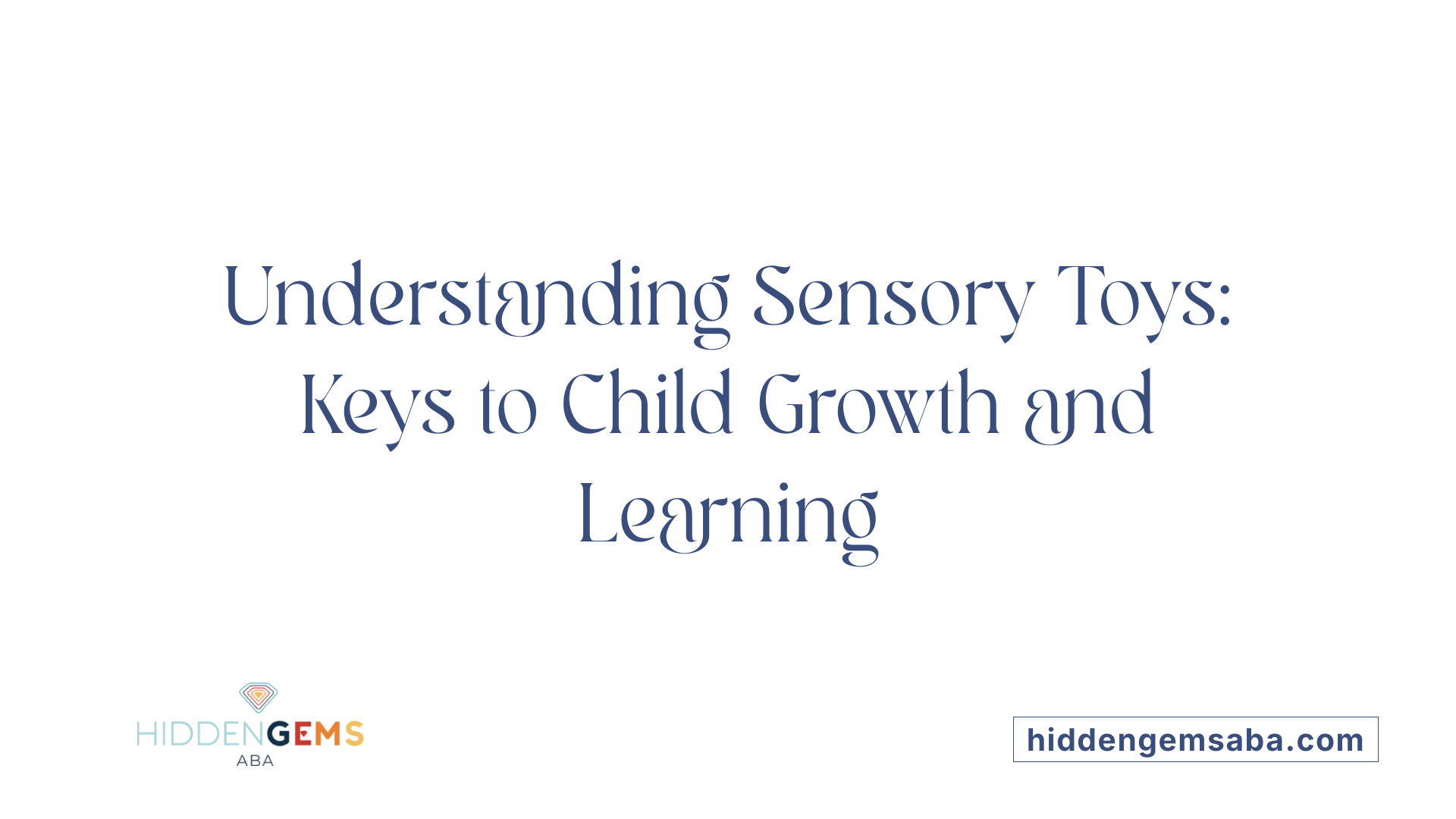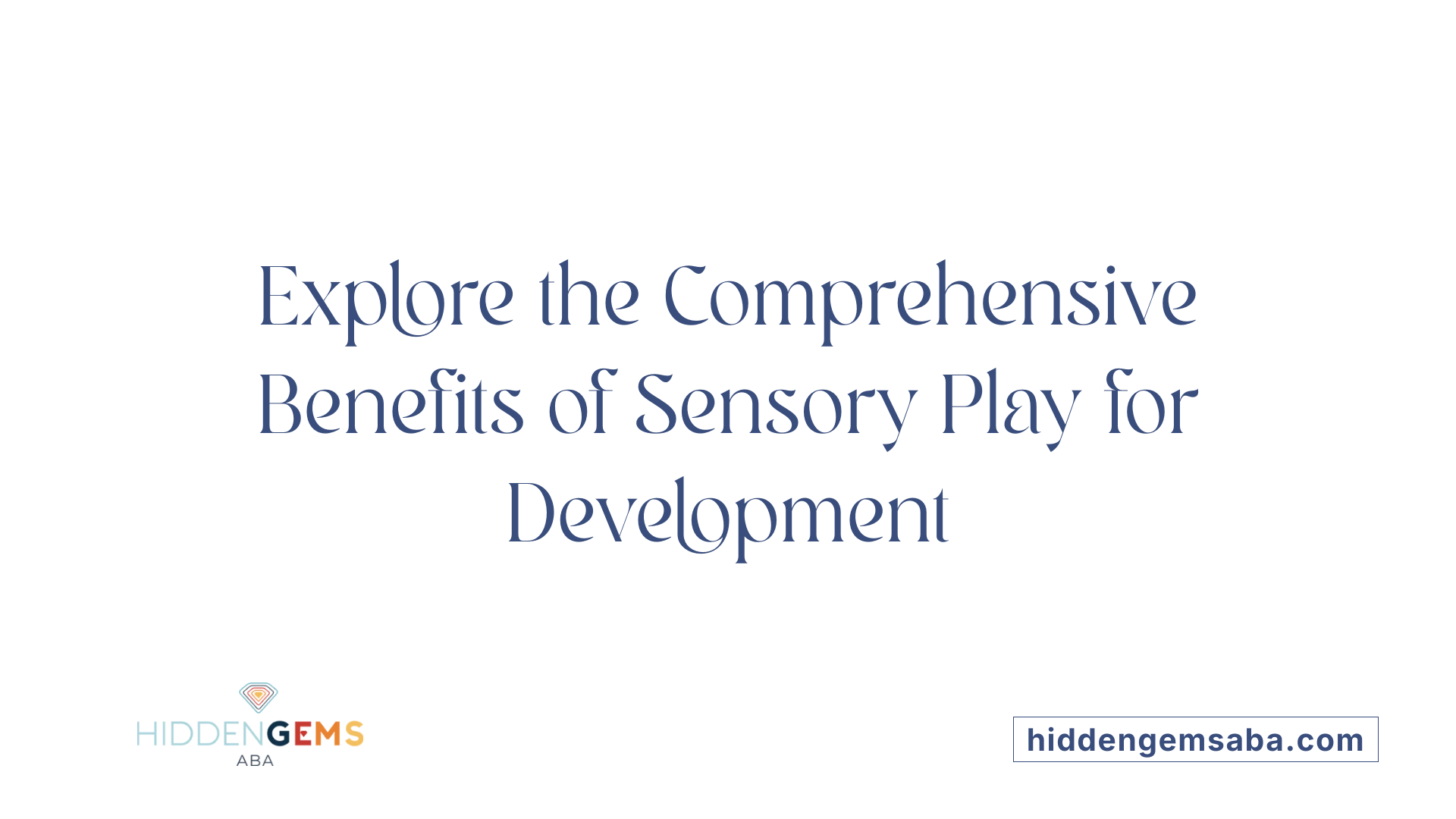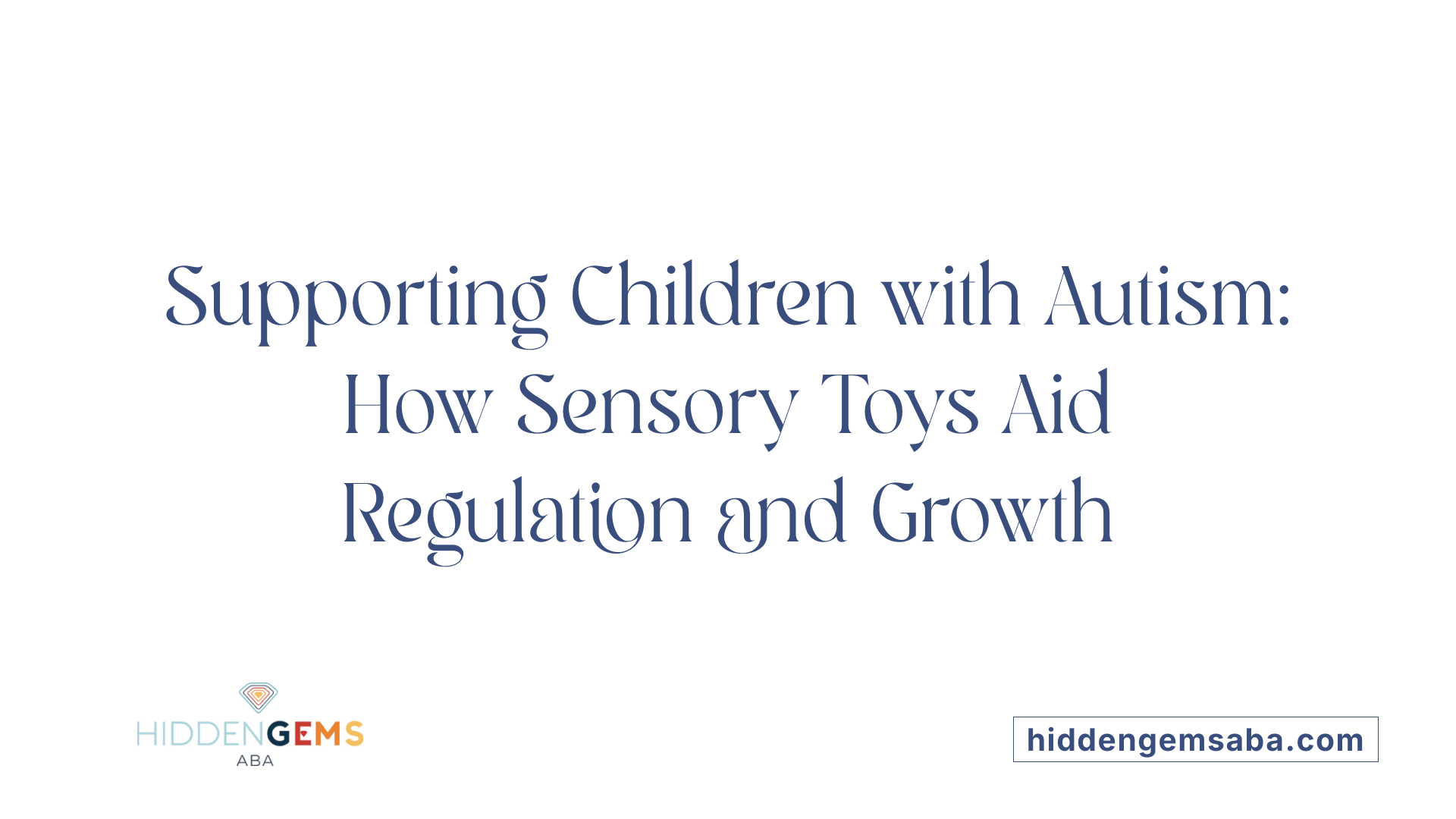Discovering the Power of Sensory Play
Sensory toys and activities play a crucial role in supporting the overall growth of children by engaging their senses—touch, sight, sound, taste, and smell. Through diverse sensory experiences, children develop essential cognitive, motor, and social skills, making sensory play a pivotal element of childhood development. This article explores how sensory toys foster learning, promote emotional regulation, support children with special needs, and serve as versatile tools for stimulating growth.
Understanding Sensory Toys and Their Role in Development

What are sensory toys, and how do they support child development?
Sensory toys are specially designed objects that stimulate one or more of the child's senses, such as touch, sight, hearing, taste, and smell. These toys include textured balls, squeeze fidgets, scented playdough, light-up lights, and vibrating items. By engaging multiple senses, they promote key areas of growth in children.
Sensory toys play a crucial role in helping children develop cognitive, social, and emotional skills. They encourage exploration and experimentation, which strengthen neural pathways in the brain. As children manipulate, squeeze, or explore these toys, they develop fine and gross motor skills, such as hand-eye coordination and strength.
For children on the autism spectrum or those with sensory processing issues, sensory toys provide predictable, calming stimuli that help regulate their emotional state. They can reduce anxiety, promote focus, and support self-regulation. Additionally, sensory play using these toys enhances language development by encouraging children to describe their sensations and feelings.
Overall, incorporating sensory toys into daily activities creates a playful environment that fosters learning, emotional regulation, and physical development, making them valuable tools for caregivers and therapists alike.
How do they support brain development?
Sensory play with toys stimulates neural connections across various regions of the brain. This stimulation fosters cognitive growth by helping children understand cause-and-effect relationships, recognize textures and patterns, and improve problem-solving skills. Consistent sensory engagement also supports memory development as children remember different sensations and associate them with experiences.
Furthermore, sensory activities promote sensory integration—the brain's ability to organize and interpret sensory information. This is essential for effective learning and behavior regulation. As children process sensory input, they develop better awareness of their bodies and environment, which forms a foundation for complex skills like writing, coordination, and communication.
How do sensory toys vary for different age groups?
Choosing appropriate sensory toys depends on a child's age and individual preferences:
| Age Group | Typical Sensory Toys | Focus of Development | Details |
|---|---|---|---|
| Babies | Textured rattles, high-contrast visuals, soft plush toys | Visual, tactile, oral exploration | Designed for safe mouthing and gentle stimulation |
| Toddlers | Playdough, water tables, textured puzzles | Fine motor skills, early problem-solving | Encourage exploration and hand-eye coordination |
| Preschoolers | Art supplies, science kits, sensory bins | Creativity, cognitive growth | Facilitate imagination and scientific thinking |
| Older children | Fidget tools, sensory bottles, outdoor activities | Focus, stress relief, advanced motor skills | Support emotional regulation and concentration |
Selecting developmentally suitable and durable sensory toys ensures children gain the most benefit while staying safe and engaged. For children with special needs, toys designed with their sensory preferences and sensitivities in mind are especially important.
The Wide-Ranging Benefits of Sensory Play

Why is sensory play important for overall development and learning in children?
Sensory play is vital for a child's growth because it engages all five senses—sight, sound, taste, touch, and smell—allowing the brain to build essential neural pathways. These connections support multiple areas including cognitive, motor, and language skills. When children explore different textures, sounds, and smells, they enhance their ability to process sensory information, which is fundamental for learning.
Through sensory activities, children also develop fine motor skills (like manipulating small objects) and gross motor skills (like jumping or running). These are crucial for everyday tasks such as writing, dressing, or playing sports. Sensory play encourages children to describe what they feel and see, helping to grow their vocabulary and understanding of the world.
Furthermore, engaging in sensory experiences helps regulate emotions and attention, fostering emotional stability and self-control. It also encourages social skills like sharing and cooperation when children play together. For children with neurodevelopmental conditions such as autism or ADHD, sensory play can reduce overstimulation or sensory sensitivities, improving their overall quality of life.
Overall, sensory play offers a fun and effective way for children to learn, explore, and develop comprehensively from infancy to childhood.
What are the benefits of sensory play for children?
Children benefit greatly from sensory play because it stimulates their sensory pathways and supports brain development. It helps create and strengthen nerve connections that underpin thinking, learning, and emotional regulation. Sensory activities also aid in improving overall motor skills, such as controlling small muscles in the hands and fingers, as well as larger movements involving the entire body.
Beyond physical development, sensory play promotes language skills by providing opportunities for children to articulate their sensations, feelings, and observations. It boosts cognitive abilities by encouraging problem-solving, pattern recognition, and cause-and-effect understanding.
Most importantly, sensory play has calming effects, helping children manage stress, anxiety, and sensory overload. It fosters social interactions, teaching children to share, take turns, and collaborate with peers. These experiences collectively support a child's emotional well-being, social competence, and independence.
In conclusion, engaging children in sensory-rich play is a cornerstone of healthy development, promoting essential skills that set the foundation for lifelong learning and emotional health.
Types of Sensory Toys and Their Specific Benefits

What types of sensory toys are available and what are their specific benefits?
Sensory toys come in a variety of forms, each designed to stimulate different senses such as touch, sight, sound, and movement. These toys are valuable tools in promoting physical, cognitive, and social development.
Examples of sensory toys include textured items like modeling dough, squishy plush toys, or bumpy squeeze toys. These enhance tactile exploration and can encourage children to learn about different textures while also fostering social interaction when played with others.
Visual sensory toys, such as light-up or color-changing objects, promote visual tracking and attention. Auditory toys, like musical mats, sound bottles, or squeaky toys, support auditory processing and help develop language skills.
Fidget toys—such as Wooden Latches Boards and Flip Fish Baby Toys—are designed to improve fine motor skills and hand-eye coordination through activities like pinching, twisting, or flipping.
In addition to physical benefits, sensory toys facilitate cognitive growth by encouraging exploration and discovery. They help children understand cause-and-effect relationships and enhance problem-solving skills.
Socially, engaging with sensory toys can teach cooperation, taking turns, and sharing, especially in group settings.
For children with neurodevelopmental needs, such as autism spectrum disorder, these toys are particularly helpful. They provide calming sensory input, improve focus, and support emotional regulation.
Overall, the variety of sensory toys offers tailored benefits for different age groups and abilities, making them essential in supporting holistic development and creating inclusive play environments.
Supporting Children with Autism and Sensory Processing Challenges

How sensory toys assist in regulation and calming
Sensory toys are powerful tools for children with autism and sensory processing challenges. They offer targeted sensory input—such as tactile textures, soothing sounds, or calming vibrations—that helps children manage overstimulation or under-responsiveness. For example, weighted blankets, chew toys, or gentle vibrating devices can provide a sense of security and comfort. These toys enable children to self-regulate their arousal levels, reducing anxiety, hyperactivity, or sensory overload. Engaging with sensory toys often calms children, creating a more stable emotional state and supporting better focus and behavior.
Building neural pathways and sensory integration
Interaction with sensory toys promotes the growth of neural connections in the brain. These activities support sensory integration—the process by which the brain organizes and interprets sensory information. Specially designed toys stimulate various senses simultaneously, encouraging the development of pathways needed for complex learning skills. Regular use of sensory toys can enhance neural efficiency, helping children better process sensory experiences, which is crucial for overall cognitive development.
Encouraging exploration and learning in neurodiverse children
Sensory toys foster an environment of exploration and discovery. They invite children to investigate textures, sounds, and visuals at their own pace, promoting curiosity and problem-solving. This kind of play encourages language development, as children describe their sensations and actions. For children on the spectrum, sensory toys also provide a safe outlet for repetitive or self-stimulatory behaviors, channeling energy into structured play. Overall, these toys support inclusive, open-ended play that nurtures growth, creativity, and learning.
| Aspect | Benefits | Examples |
|---|---|---|
| Sensory Regulation | Reduces anxiety and hyperactivity | Weighted blankets, chew toys |
| Neural Development | Strengthens brain pathways for complex thinking | Textured balls, sensory bottles |
| Learning and Exploration | Promotes problem-solving, language, and curiosity | Playdough, tactile puzzles |
| Social and Emotional Growth | Supports calm interaction and self-awareness | Group activities, shared sensory play |
Sensory toys are essential in the toolkit for supporting children on the spectrum. They provide meaningful sensory input, aid in neural development, and encourage joyful exploration—paving the way for greater independence and well-being.
Embracing Sensory Play for Lifelong Benefits
Incorporating sensory toys and activities into a child's daily routine offers profound benefits that support holistic development, emotional regulation, and social interaction. These tools help children explore their environment confidently, develop essential skills, and foster creativity. For children with autism or sensory sensitivities, sensory toys serve as vital resources for calming, focus, and self-regulation. By understanding their importance, parents and caregivers can create enriched, inclusive play experiences that nurture a child's growth and curiosity—building a foundation for lifelong learning and well-being.
References
- What is a Sensory Toy and How Can they Help?
- The Benefits of Sensory Play For Your Child
- What are sensory toys and how do they help? - Autism Speaks
- The Power Of Sensory Play In Childhood Development - Forbes
- Top 5 Benefits of Sensory Play - Infantino
- The Benefits of Sensory Toys for Children with Autism
- The Benefits of Sensory Toys and Support Tools
- Exploring the Benefits of Sensory Play for Children






